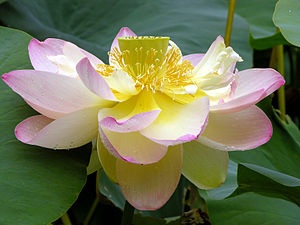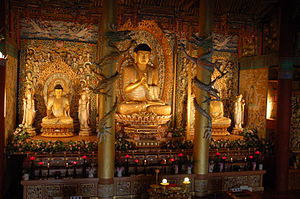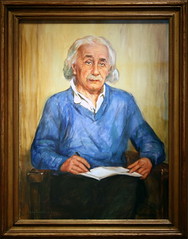 Image via Wikipedia
Image via Wikipedia
L.D. Turner
There are thousands of ways to unnecessarily complicate the spiritual journey and I can safely say that I have tried just about all of them. I say this not so much to brag, but instead, to point out that I possess a wealth of experience in that highly arcane, patently esoteric spiritual practice of wasting time. If nothing else, the words wasted and verbiage expended in this opening paragraph should serve as ample proof that I am more than capable of beating around the proverbial bush with the best of them.
Although my modes of written expression are still far from Hemingwayesque, I have learned to simplify things quite a bit. This truth holds for both my writing and my spiritual pursuits. Nowadays, I like to keep things simple.
I suspect that my affection for simplicity has been around for a long time, lurking perhaps beneath a veneer of intellectual snobbery and psycho-spiritual babbling. What else can possibly explain my 40-year dance with the teachings of Buddhism? If ever a man sought to keep things simple, straightforward, and practical, it was Buddha. I know, yes, I know all about those long, dreary lists of psychological problems found in the depths of human ignorance, as well as the ten this, and the twelve that. Like any religion, Buddhism can get a bit weighty, but what attracts me most is the stark simplicity one finds in the practical “where-the-rubber-meets-the-road” teachings. For example, I am especially fond of this trilogy:
Avoid Doing Harm;
Seek to do Good;
Master the Mind;
In terms of simplicity, it doesn’t get any better than this.
All major spiritual traditions recognize the importance of ethical living and these three lines form the bedrock of
Buddhist ethics. Unfortunately, in our post-modern culture the notion of morality and ethical conduct often is either downplayed or overlooked entirely. On the spiritual path, to do either is deadly.
Sacred Character begins with our personal conduct and our personal conduct flows from an internalized value system that we view as important. We need to know and know in depth just what we believe to be right and wrong. Again, this issue is often glossed over in our post-modern world and this is in many ways a tragedy.
Here is the foundational truth to get down in the depth of your being: Your value system, your sense of personal ethics, is the foundation upon which your spiritual journey is constructed. Without a system of personal morality, you are building your house on sand.
Having a personal sense of morality is only the beginning. If you don’t act on your value system – if you don’t put it into practice – you are going nowhere. You are like a house divided against itself. You, my friend, cannot stand. If you do not act on your beliefs of right and wrong, you will lack integrity. And without integrity, there can be no integration. Hopefully, you see the connection between these two words.
In Buddhism, the second paramita is called ethics. The Sanskrit term for this concept is sila. Suyra Das, in speaking of sila as it relates to the sacred path of the Bodhisattva, tells us:
We need guidelines to plan, chart, assess, and inspire our progress as Bodhisattvas, and we find them in the realm of moral ethics. This realm includes the virtues associated with living more wisely, compassionately, and harmoniously among others on an everyday basis. Among these moral virtues are self-discipline, integrity, decorum, faithfulness, temperance, tact, justice, honesty, reverence, and modesty. Bringing these qualities into our practical lives gives us integrity and good character, precisely because we’re synchronizing our three levels of being – outer, inner, and secret – on a moment-by-moment, day-by-day, year-by-year basis. When we’re doing this, we’re living the good life and helping to usher in a better world.
Suyra Das goes on to elaborate on the meaning of the word sila:
The Sanskrit word sila means “that which cools or calms.” In this context, cooling or calming refers to taming the virulent, seething passions that can easily overwhelm us, sometimes damaging ourselves as well as others. Specifically, the practice of ethics serves as an antidote to our tendencies to be careless, meretricious, irresponsible, cruel, false, exploitative, and unfair. Moral living exemplifies compassion in action.
Take a few minutes and become quiet and centered. Now, please focus on the last sentence in the preceding words from Suyra Das.
“Moral living exemplifies compassion in action.”
Such profound and true words and, if we can apply this attitude to our daily living, we will indeed become better persons. Our moral beliefs are directly related to how we interact with the world. If we have internalized the value of compassion and behave in accordance with that belief, we put compassion into action and help make the world a better place. All so simple, yet so profoundly true.
One of my favorite classic western movies is “The Best of the Bad Men.” In this vintage film, most of the famous outlaws of the Old West had managed to come together to pull a bank job. The James brothers, the Daltons, the Youngers…they were all there. Somehow Walter Brennan was a part of the gang, but not a member of any of the outlaw families. Still he played a vital role in the movie.
At one point, two of the bad guys were about to have a gun fight at the bottom of a hill where the gang was camped. Walter Brennan came running down the hill with his six-shooter aimed at both of them. Next, in his unmistakable voice, Brennan told them to back off or he would lay both of them out. To emphasize his point, Brennan then said:
“I ain’t kin to none of ya….and I ain’t troubled by no burdensome scruples.”
The view espoused by Walter Brennan may seem humorous in the context of the movie, but it reflects how many people in our culture have come to see morality. More than a few individuals hold the idea that having internalized values is too restrictive, reduces our freedom, and takes the fun out of life. The fact is, just the opposite is true. Listen to Suyra Das:
Individuals with a strong sense of sila, or ethics, are true to standards that reflect and elicit not only the best in themselves but also the best among human beings in general. They make promises to themselves and others to uphold these standards, but once these promises become second nature to them, they don’t restrict their lives, as others might expect they would. Instead, these promises lend clarity and power to their lives, allowing them more freedom and opportunity to live positively, grow spiritually, and help others naturally along the way.
No, a strong sense of personal values does not restrict our freedom. Instead, it gives us parameters to operate by, facilitates easier decision-making, and, in a sense, helps us define who we are. Values also help us to keep flowing forward toward our goals in life, especially our spiritual goals. Values can be seen as being like the banks of a river; they keep the water flowing toward its destination. Without banks, a river becomes a swamp.
A
personal value system serves other positive purposes as well. Each of us it seems is equipped not only with a Sacred Center, but also with a lower center. This lower center is dominated by the ego and its selfish mind set. As a result, even the best of us engage in behaviors which are less than stellar. Speaking of myself, I know that I try to approach life as much as possible from a positive and sacred viewpoint. Still, there are times when I act with selfishness, anger, a mean spirit, and an overall sense of negativity. Having an internalized set of values, a personal moral code if you will, helps me not only identify when I am going off the spiritual rails, it also tends to reduce the frequency with which I behave in a negative manner.
As our world culture moves forward in this new and challenging century, the importance of each individual developing and maintaining an internalized, spiritual value system – one based on inter-connectivity and human compassion – is essential. More to the point, each person has to act on that value system. He or she must be the same inside and outside. This is the true meaning of integrity.
So, where do we start? Why not keep it simple? I suspect we all could:
Avoid doing harm
Seek to do good
Master the Mind
© L.D. Turner 2009/All Rights Reserved
 Image via Wikipedia
Image via Wikipedia



















